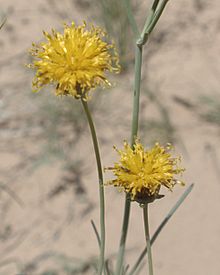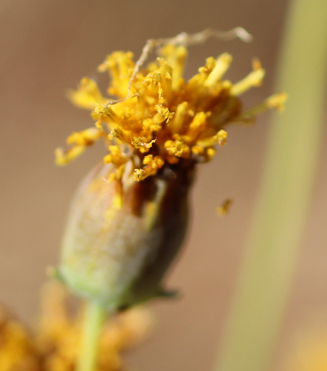
Location
On side of road beween Park Headquarters and entrance toward #16 (N35D32'56.807 X W105D41'15.600)
Flowers first observed: 6/21/17
The Plant w/Flowers
The Flower
 |
 |
Distribution
"Flowering Jul–Sep. Disturbed sites, fields, roadsides; 10–600+ m; introduced; Alta., B.C., Man., N.B., Nfld. and Labr. (Nfld.), N.S., Ont., Que., Sask.; Alaska, Ark., Calif., Conn., Idaho, Ill., Iowa, Maine, Md., Mass., Mich., Minn., Mo., N.H., N.J., N.Y., N.Dak., Ohio, Oreg., Pa., R.I., S.Dak., Utah, Vt., Va., Wash., W.Va., Wis., Wyo.; Europe, Asia." (Flora of North America)
Description
"Leaves 1–3(–5) cm, ultimate lobes narrowly oblong to spatulate or linear, ultimate margins entire or serrate (teeth apiculate). Phyl-laries: abaxial faces sericeous to arachnose, margins often ciliolate. Paleae 4–5 mm (including spinose tips). Ray laminae yellow, 6–12+ mm. Disc corollas 3.5–4 mm. Cypselae 1.8–2.2 mm; pappi usually 2–2.5 mm. 2n = 18." (Flora of North America)
Ethnobotanical Uses
Medicine:
"A mild diuretic useful in water retention and urethra irritations. Cota is mildly antiseptic to the urinary tract. Not a strong remedy, it can be useful because of its lovely taste. It makes a cooling summer ice tea with some Spearint and pilocillo (Mexican cone sugar). Like Spearmint, it is a good tea for convalescence, also useful for indigestion and mild fever. For the inveterate tea drinker, Cota can be positively addicting: along with Poleo and Morman Tea, it is one of our three best native teas, a redddish beverage with disticnctive aroma and flavor. It is a traditional beverage of many Spanish New Mexicans, as well as a widely used folk remedy for arthritis, kidney, and blood complaints. It is used with alva (Malva negleta) as a skin wash for diaper rash and thrush. Aong the Pueblo Indians its use is ancient; Cota twigs was even found with pottery shards in Chaco Canyon. " (Moore 66)
Other Uses:
"Dye Color and Parts Used for Dye: Flowers, leaves and stems can be used to achieve yellow, orange-yellow and buff dyes in wool mordanted with alum or alum and cream of tartar. Plant parts can be harvested throughout the growing season, according to Jenny Dean (ref. 3). Eva Lambert & Tracy Kendall (ref. 6) recommend using only freshly harvested flowers.
Other Information: Dyer’s chamomile was used as a dye in Medieval times, although apparently not as often as other traditional sources of yellow dyes, such as weld. Seeds of this plant have been found in excavations in southwestern Finland dated back to the 14th to 16th centuries, suggesting use as a dye plant and/or medicinal plant. In more recent times, laboratory tests have shown that phenolic compounds and flavonoids extracted from these plants to be effective, at relatively low doses, against bacteria such as Staphylococcus aureus and Pseudomonas aeruginosa , and some compounds (especially conduritol and patulin) extracted from the plant are good scavengers of free radicals(ref. 9). One study (ref. 5) undertaken to determine color fastness of dyer’s chamomile as a possible commercial dye plant determined that the dye holds up well against washing, rubbing and sweat, but is not as light-fast as would be desired for commercial dyes. Field studies showed that the plants could be successfully grown for 1 or 2 years, and the authors recommended more studies as this might be a commercially successful crop." (RM Weavers Guild)
Internet Links
